An Ensemble Learning-Based Predictive Model for the Classification of Churn
Main Article Content
Abstract
Advances in ensemble learning and data analytics have transformed how businesses handle the problem of customer churn. Companies used customer surveys to get feedback and improve their services before predictive models were developed. Recognizing customer churn as a critical issue implies understanding that when customers leave a business at a higher rate than desired, it indicates deeper problems or challenges within the organization. The features that are associated with the classification of churn among customers were identified from literature following which relevant data was collected from an online repository provided online by Kaggle. The predictive model for the classification of churn among customers was simulated using the holdout method based on three simulation runs for the two ensemble learning models LightGBM and Bagging with Decision Tree. The results of the study showed that among the ensemble methods adopted, the LightGBM classifier proved to have the best overall performance among all the ensemble models considered having 100% accuracy through the three simulation. However, it was observed that as the proportion of the training datasets increased, the performance of the machine learning classifiers improved. The features that are most important to the classification of churn among customers include: type of customer contract, tenure of using service, satisfaction level of customer support, online security service, device protection service, payment methods, and streaming services. The study concluded that each feature had a importance to one another regarding their usefulnessin the classification of churn.
